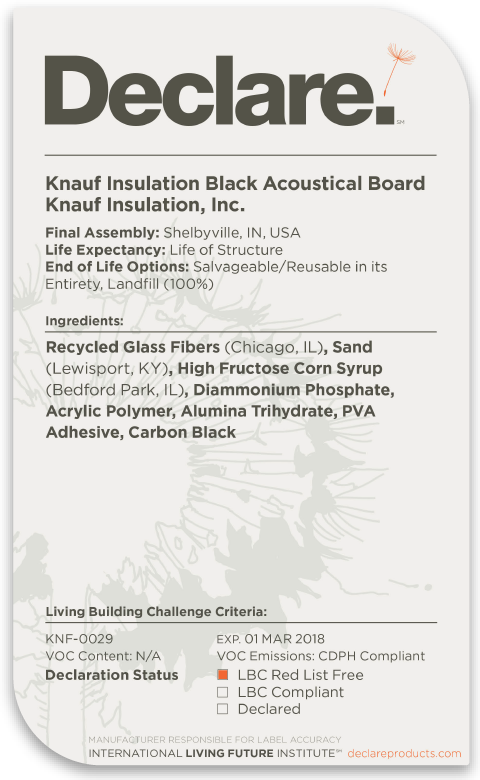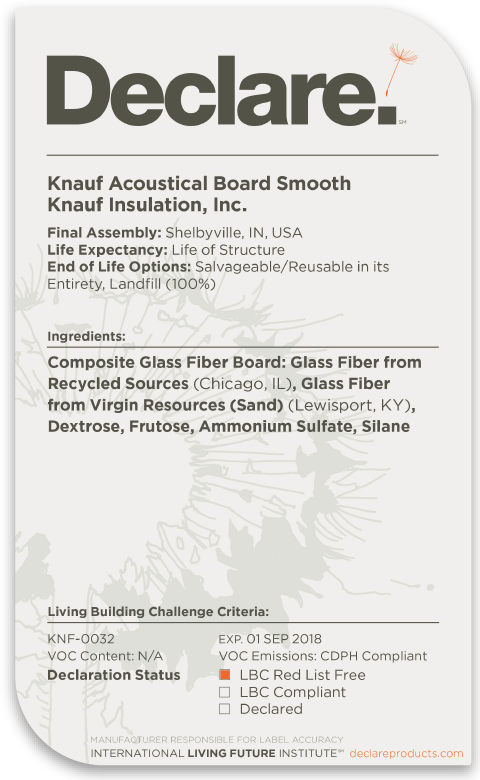LCA & material health results & interpretation Black Acoustical Board and Acoustical Smooth Board
Evaluation program
Declare labels are issued to products disclosing ingredient inventory, sourcing and end of life options. Declare labels are based on the Manufacturers Guide to Declare, administered by the International Living Future Institute.
How it works
Material ingredients are inventoried and screened against the Living Building Challenge (LBC) Red List which represents the ‘worst in class’ materials, chemicals, and elements known to pose serious risks to human health and the greater ecosystem.
Assessment scope and results
Declare™
Inventory threshold: 100 ppm
Declare level:
The Declare product database and label are used to select products that meet the LBC's stringent materials requirements, streamlining the materials specification and certification process.
Click the label to see the full declaration.
Black Acoustical Board |
Acoustical Board Smooth |
|---|---|

|

|
What's in this product and why
Declare level
Black Acoustical Board and Acoustical Smooth Board have no Red List chemicals. The Red List is a list of chemicals that are not allowed in Living Building Challenge buildings. Being Red List free is our design benchmark at Knauf.
These products utilize a bio-based binder chemistry derived from corn that is formaldehyde-free and more interior friendly than phenol-formaldehyde (P/F) systems. This product transformed the industry, moving away from P/F systems and toward bio-based binder adhesive systems for these types of products.
What's in the product and why
The ingredients of Black Acoustical Board and Acoustical Smooth Board avoid the 800+ chemicals of the Living Building Challenge Red List. This is primarily because of its bio-based binder adhesive chemistry known as ECOSE® Technology. ECOSE is based on dextrose or high fructose corn syrup instead of phenol and formaldehyde. Dextrose and fructose can be used interchangeably. The ECOSE binder allows the product to be validated by the UL Environment as formaldehyde-free. Formaldehyde is a Red List chemical.
Knauf Insulation board products are the only formaldehyde-free glass mineral fiber boards available in the marketplace today.
What's been done in the design and manufacture in consideration of the potential human health impacts in the use stage
Knauf led the industry in bio-based development to avoid phenol and formaldehyde in our processes beginning in 2008. This development was likely the largest green chemistry disruption of our era. Today, our competitors have followed or are striving to meet this benchmark.
The primary ingredient in this product is recycled glass. While recycled content may vary from year to year, the recycled content is currently greater than 60% by weight. The second largest content is silica sand which is sourced as locally as possible. The third largest ingredient is corn-based syrup (dextrose or fructose). As a result of using plant-based binders, the VOC profile of this product is very interior friendly.
The emission from our factories is also much better for our communities. We ensure our glass formulations have no serious health concerns by allowing our processes to be audited to meet European Certification Board for Mineral Wool Products (EUCEB) biosolubility requirements.
Where it goes at the end of its life
At this time, the product is landfilled at end of life. We take extended producer responsibility very seriously and have active programs to address end of life. There is no option other than landfills at this time.
How we're making it healthier
Knauf engages very closely with its vendors to eliminate and avoid chemicals of concern. No competitor has as many Red List free products as Knauf Insulation. We continually reduce our environmental impacts through recycled content and optimize our products by designing them to be transformative.
See how we make it greenerReferences
Declare
Black Acoustical Board
Acoustical Board Smooth
Manufacturer's Guide to Declare
A comprehensive guide providing information about the program, the assessment methodology, how to submit material data to obtain a Declare label and how they are used to meet the Health & Happiness and Materials Petals of the Living Building Challenge.
Log into your Project Library
${ loginErrorMessage }
Create my SM Transparency Catalog Project Library
You can save projects, download project packages, get spec help and request a quote.
Create my Project LibraryCreate my SM Transparency Catalog Project Library
You can save projects, download project packages, get spec help and request a quote.
We will never sell, loan, rent, trade, exchange, or share your name or your email with anyone.
Read our privacy policy.

 SM Transparency Report (EPD)
SM Transparency Report (EPD) 